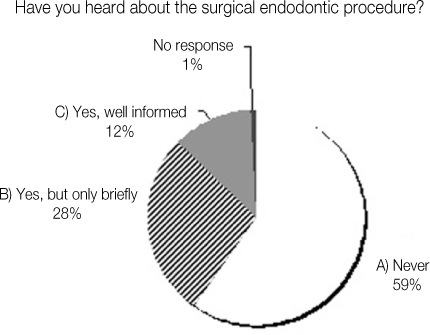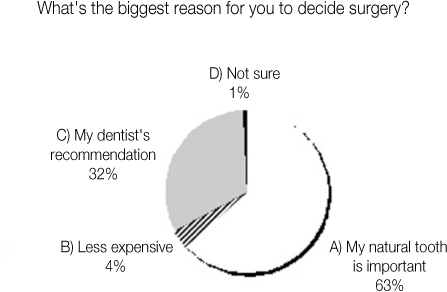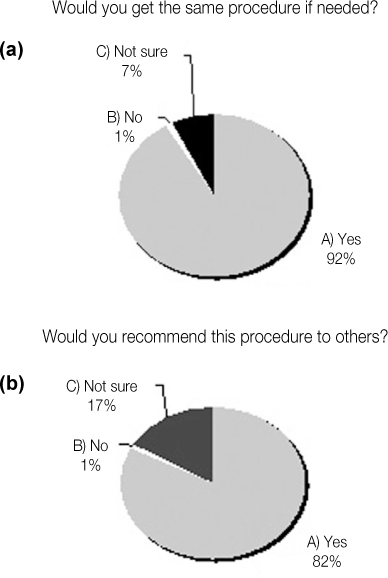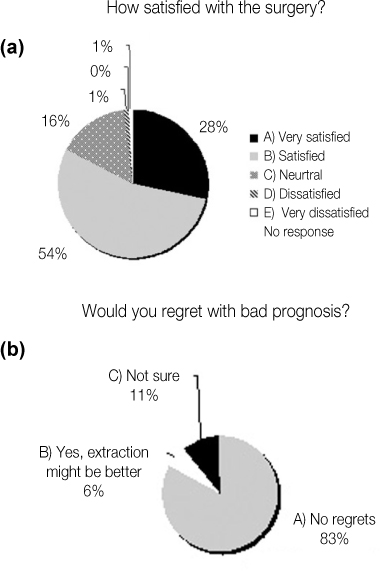J Korean Acad Conserv Dent.
2011 Mar;36(2):114-118. 10.5395/JKACD.2011.36.2.114.
Patients' perception and satisfaction with apicoectomy
- Affiliations
-
- 1Department of Conservative Dentistry, Yonsei University College of Dentistry, Seoul, Korea. shujungshin@yahoo.com
- KMID: 2251815
- DOI: http://doi.org/10.5395/JKACD.2011.36.2.114
Abstract
OBJECTIVES
This study was aimed to examine the patients' perception and satisfaction with the results of endodontic microsurgery which was apicoectomy with retrofilling.
MATERIALS AND METHODS
A questionnaire was given to 109 patients, who were recalled after a minimum of 3 months upon endodontic microsurgery in the Department of Conservative Dentistry, Yonsei University. A contingency table and correlation analysis were used to determine if there were any correlations between age/gender and the patients' responses (p = 0.05).
RESULTS
Approximately 60% of respondents answered they had never heard of surgical endodontic procedures. 63.3% of respondents chose the surgical option because they wanted to keep their natural teeth. If the patient required the same procedure on another tooth later, 100 out of 109 respondents answered they would choose microsurgery instead of extraction. Most patients (82.57%) appeared to be satisfied with the surgical procedure.
CONCLUSIONS
Endodontic microsurgery consisting of apicoectomy and retrofilling seems to appeal to majority of patients as a satisfactory and valuable treatment choice.
Keyword
Figure
Reference
-
1. Rubinstein RA, Kim S. Long-term follow-up of cases considered healed one year after apical microsurgery. J Endod. 2002. 28:378–383.
Article2. Saunders WP. A prospective clinical study of periradicular surgery using mineral trioxide aggregate as a root-end filling. J Endod. 2008. 34:660–665.
Article3. Torabinejad M, Corr R, Handysides R, Shabahang S. Outcomes of nonsurgical retreatment and endodontic surgery: a systematic review. J Endod. 2009. 35:930–937.
Article4. Zuolo ML, Ferreira MO, Gutmann JL. Prognosis in periradicular surgery: a clinical prospective study. Int Endod J. 2000. 33:91–98.
Article5. Kim E, Song JS, Jung IY, Lee SJ, Kim S. Prospective clinical study evaluating endodontic microsurgery outcomes for cases with lesions of endodontic origin compared with cases with lesions of combined periodontal-endodontic origin. J Endod. 2008. 34:546–551.
Article6. Hassel AJ, Wegener I, Rolko C, Nitschke I. Self-rating of satisfaction with dental appearance in an elderly German population. Int Dent J. 2008. 58:98–102.
Article7. Lee TC, McGrath CP, Wong RW, Rabie AB. Patients' perceptions regarding microimplant as anchorage in orthodontics. Angle Orthod. 2008. 78:228–233.
Article8. Harrison P, Polyzois I, Houston F, Claffey N. Patient satisfaction relating to implant treatment by undergraduate and postgraduate dental students-a pilot study. Eur J Dent Educ. 2009. 13:184–188.
Article
- Full Text Links
- Actions
-
Cited
- CITED
-
- Close
- Share
- Similar articles
-
- Adolescents' Satisfaction of Body and Self-Esteem According to Obesity and Subjective Perception of Body: Verification of Moderating Effect of Sex
- A Study on the Job Satisfaction of Visiting Nurses of Public Health Centers in Korea
- Perception and Satisfaction of Anticancer Drug Clinical Trials in Cancer Patients
- The Relation between Sex Perception, Sex Life Satisfaction, and Life Satisfaction of the Elderly
- Patinets' Perception and Satisfaction with Nursing Care in Korea





